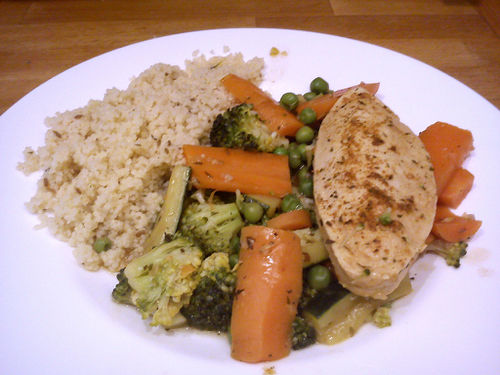Synfood: Difference between revisions
m (moved link; added process example) |
|||
| Line 1: | Line 1: | ||
[[File:Quorn1.jpg|500px|thumb|right|"Quorn and vegetable tagine with cous-cous" (photo by Flickr user "mp-media").]] | [[File:Quorn1.jpg|500px|thumb|right|"Quorn and vegetable tagine with cous-cous" (photo by Flickr user "mp-media").]] | ||
The concept known as [https://en.wikipedia.org/wiki/Single-cell_protein “single cell protein”] refers to the production of dietary protein using microbial organisms. These could be bacterial or fungal organisms that metabolize various chemicals, such as multi-carbon compounds, but also methanol, methane and even hydrogen. One of the well-researched organisms in this field is ''Methylophilus methylotrophus''. “Pruteen” synfood failed in the 1980's because of the high cost of natural gas at that time. Would it work now (2016) with today's lower gas prices? | The concept known as [https://en.wikipedia.org/wiki/Single-cell_protein “single cell protein”] refers to the production of dietary protein using microbial organisms. These could be bacterial or fungal organisms that metabolize various chemicals, such as multi-carbon compounds, but also methanol, methane and even hydrogen. One of the well-researched organisms in this field is ''Methylophilus methylotrophus'' which utilizes [[methanol]]. “Pruteen” synfood failed in the 1980's because of the high cost of natural gas at that time. Would it work now (2016) with today's lower gas prices? | ||
==Terminology== | ==Terminology== | ||
While this concept is called ''"single cell protein"'', it is not limited to the production of proteins but can include any food component such as carbohydrates and fats. This needs to be re-branded with a better name - perhaps “synfood”, analogous to “synfuel”. | While this concept is called ''"single cell protein"'', it is not limited to the production of proteins but can include any food component such as carbohydrates and fats. This needs to be re-branded with a better name - perhaps “synfood”, analogous to [https://en.wikipedia.org/wiki/Synthetic_fuel “synfuel”]. | ||
==Process Example: Pruteen== | |||
1.) Methanol, ammonia and other nutrients are mixed together | |||
2.) Steam sterilization of the mixture | |||
3.) Mixture is put into a fermenter that is at 40C and kept under high pressure (to keep ammonia dissolved) using [[Compressed Air | pressurized air]] | |||
4.) Some substrate is constantly removed from the fermenter, acidified and heated (result: cells separate out) | |||
5.) The leftover fluid is recovered, steam sterilized and added back | |||
6.) Extracted cells are dried | |||
==Intellectual property situation== | ==Intellectual property situation== | ||
This is old technology (see [https://en.wikipedia.org/wiki/Single-cell_protein Wikipedia entry] for more information). However, it is a very broad field and parts of it may be covered by patents. | This is old technology (see [https://en.wikipedia.org/wiki/Single-cell_protein Wikipedia entry] for more information). However, it is a very broad field and parts of it may be covered by patents. | ||
* US Patent #3778349 (1971) | * US Patent #3778349 (1971): ''"Production of single cell protein material"'' via [http://www.freepatentsonline.com/3778349.html FreePatentsOnline] and [https://www.google.com.ar/patents/US3778349 Google Patents]. | ||
* US Patent #4652527 (1987): [http://www.google.com/patents/US4652527 ''"Process for culturing methylophilus methylotrophus"''] | |||
==Overall impact== | ==Overall impact== | ||
| Line 24: | Line 39: | ||
* [http://nextbigfuture.com/2015/05/natural-gas-fracked-bacterial-fishmeal.html NextBigFuture: ''"Natural Gas Fracked bacterial fishmeal can save the worlds fish and enable a lot more farmed fish"''] | * [http://nextbigfuture.com/2015/05/natural-gas-fracked-bacterial-fishmeal.html NextBigFuture: ''"Natural Gas Fracked bacterial fishmeal can save the worlds fish and enable a lot more farmed fish"''] | ||
* Wikipedia: [https://en.wikipedia.org/wiki/Quorn Quorn] and [https://en.wikipedia.org/wiki/Single-cell_protein Single Cell Protein] | * Wikipedia: [https://en.wikipedia.org/wiki/Quorn Quorn] and [https://en.wikipedia.org/wiki/Single-cell_protein Single Cell Protein] | ||
* http://biomaster2011.blogspot.ca/2011/03/scp-derived-from-bacteria.html | * http://biomaster2011.blogspot.ca/2011/03/scp-derived-from-bacteria.html | ||
[[Category:Food and Agriculture]] | [[Category:Food and Agriculture]] | ||
[[Category: Materials]] | [[Category: Materials]] | ||
Revision as of 23:16, 3 July 2016
The concept known as “single cell protein” refers to the production of dietary protein using microbial organisms. These could be bacterial or fungal organisms that metabolize various chemicals, such as multi-carbon compounds, but also methanol, methane and even hydrogen. One of the well-researched organisms in this field is Methylophilus methylotrophus which utilizes methanol. “Pruteen” synfood failed in the 1980's because of the high cost of natural gas at that time. Would it work now (2016) with today's lower gas prices?
Terminology
While this concept is called "single cell protein", it is not limited to the production of proteins but can include any food component such as carbohydrates and fats. This needs to be re-branded with a better name - perhaps “synfood”, analogous to “synfuel”.
Process Example: Pruteen
1.) Methanol, ammonia and other nutrients are mixed together
2.) Steam sterilization of the mixture
3.) Mixture is put into a fermenter that is at 40C and kept under high pressure (to keep ammonia dissolved) using pressurized air
4.) Some substrate is constantly removed from the fermenter, acidified and heated (result: cells separate out)
5.) The leftover fluid is recovered, steam sterilized and added back
6.) Extracted cells are dried
Intellectual property situation
This is old technology (see Wikipedia entry for more information). However, it is a very broad field and parts of it may be covered by patents.
- US Patent #3778349 (1971): "Production of single cell protein material" via FreePatentsOnline and Google Patents.
- US Patent #4652527 (1987): "Process for culturing methylophilus methylotrophus"
Overall impact
This field has failed to take off in the past but could have major impact on food production, especially meat production. This has the potential to dramatically reduce the demand for pasture land in particular, and for other agricultural land as well. Syngas from biomass could be turned into food. Genetic modification of these microbes can further optimize yield.
Potential uses
- methane from biogas => synfood
- extensions: solar hydrogen, hydrogen and methane from pyrolysis of biomass (via "water-gas-shift" reaction), etc.
- hydrogen => methane => methanol => food, biofuels (see: Methane to methanol)
- methanol from wood => synfood
- Other related pages: biorefinery
